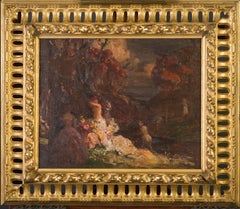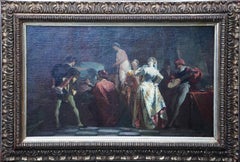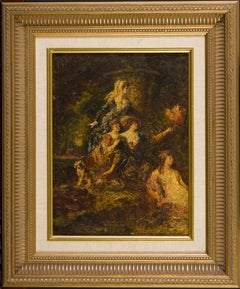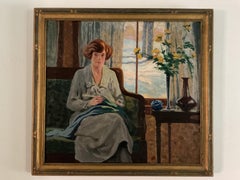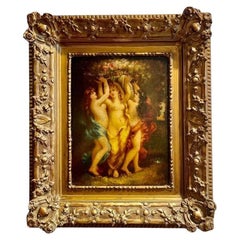Adolphe Monticelli Art
French, 1824-1886
Adolphe Joseph Thomas Monticelli, widely known as Adolphe Monticelli, was a French painter whose vibrant and expressive style preceded the Impressionist movement. Born in Marseille in 1824, Monticelli embarked on his artistic journey at the age of eighteen by attending the École Municipale de Dessin in his hometown from 1842 to 1846. He then moved to Paris to further his studies under the tutelage of Paul Delaroche at the prestigious École des Beaux-Arts.
While in Paris, Monticelli honed his skills by making meticulous copies of works by the Old Masters in the Louvre and creating oil sketches inspired by Eugène Delacroix. His technique evolved significantly during this period, laying the foundation for his distinctive style.
In 1855, Monticelli met Narcisse Diaz, an artist associated with the Barbizon School. The two frequently painted together in the forest of Fontainebleau. Monticelli was influenced by Diaz’s practice of incorporating nudes or elegantly dressed figures into landscapes, a motif that would recur in his own work.
Monticelli developed a highly individual Romantic style characterized by richly colored, dappled, and textured surfaces. His paintings, with their scintillating effects, often depicted courtly subjects inspired by Antoine Watteau. Additionally, he created still lifes, portraits, and Orientalist scenes, drawing inspiration from Delacroix’s oil paintings.
In the 1860s, Monticelli befriended the young Paul Cézanne, and his influence is evident in Cézanne’s work from that decade. Despite his growing prowess and the significant output of his work, Monticelli lived in poverty after returning to Marseille in 1870. He sold his paintings for meager sums, driven solely by his passion for art rather than financial gain.
From 1878 to 1884, Monticelli and Cézanne often painted together, exploring the landscapes of Aix-en-Provence. Monticelli’s dedication to his craft was reflected in his remark, “I paint for thirty years from now,” suggesting a forward-looking vision that anticipated future artistic developments.
Monticelli’s work, with its painterly freedom and expressive use of color, prefigured that of Vincent van Gogh. Van Gogh, who greatly admired Monticelli’s work after seeing it in Paris in 1886, adopted a brighter palette and heavier brushstrokes influenced by Monticelli’s style. Unfortunately, Monticelli passed away in Marseille in 1886, just a few months before Van Gogh arrived in Paris, and the two artists never met.
In 1886, Monticelli’s distinctive style and technique captured the attention of critics and admirers at the Salon des XX. His nervous and broad brushstrokes, along with a remarkably rich palette, made his work instantly recognizable. He painted a variety of subjects, including imaginary festive scenes, expressive portraits, sensual nudes, vibrant still lifes, and lively circus scenes, all characterized by a unique vivacity and color that continue to be admired in the art world today.
Adolphe Monticelli’s legacy is that of an influential French painter who, despite a life of poverty, left a lasting impact on the art world. His friendship with Cézanne, his influence on Van Gogh, and his vibrant, expressive style ensure that his work remains celebrated and studied long after his time.to
1
3
3
2
The Bathers ( Les Bagneuses )
By Adolphe Monticelli
Located in Douglas, Isle of Man
Adolphe Joseph Thomas Monticelli 1824-1886, was a French painter and influencer of Vincent van Gogh. Monticelli was well known to Theo and Vincent Van Gogh, Theo acted as agent for ...
Category
Late 19th Century Adolphe Monticelli Art
Materials
Canvas, Oil, Panel
Artist in his Studio - French 19th century art figurative interior oil painting
By Adolphe Monticelli
Located in Hagley, England
This lovely French 19th century figurative Impressionist oil painting is by Adolphe Monticelli. Painted circa 1870 the painting depicts a group of seven figures amusing themselves in...
Category
19th Century Realist Adolphe Monticelli Art
Materials
Oil
Fete Gallant
By Adolphe Monticelli
Located in Douglas, Isle of Man
Adolphe Joseph Thomas Monticelli 1824-1886, was a French painter and influencer of Vincent van Gogh. Monticelli was well known to Theo and Vincent Van Gogh, Theo acted as agent for ...
Category
Late 19th Century Adolphe Monticelli Art
Materials
Oil, Panel, Mahogany
Related Items
Thoughtful woman on the terrace of the bar oil on canvas painting
Located in Sitges, Barcelona
Frederic Cabanas (1954) - Pitussi - Oil on canvas
Oil measurements 92x65 cm.
Without frame.
Frederic Cabanas
Multifaceted artist, painter, sculptor, musician, photographer, wr...
Category
1980s Fauvist Adolphe Monticelli Art
Materials
Canvas, Oil
$1,062 Sale Price
43% Off
H 36.23 in W 25.6 in
Fine American Impressionist Interior and Portrait Painting, 1922, Boston area
Located in Baltimore, MD
Born in Cambridge, Massachusetts in 1891, John Gilmore Wolcott graduated from Harvard in 1914 and continued studies in art with Charles Woodbury. He was active in the Boston art scen...
Category
1920s American Impressionist Adolphe Monticelli Art
Materials
Oil
$1,295
H 26 in W 28 in D 2 in
19th Century European Realist Art Nouveau Young Woman Portrait Framed Painting
Located in Buffalo, NY
Antique European realist portrait oil painting. Oil on canvas. Framed. In excellent original condition. Handsomely framed in a wood molding. Excellent condition, ready to hang ...
Category
1880s Realist Adolphe Monticelli Art
Materials
Oil, Board
$1,180 Sale Price
20% Off
H 28 in W 22 in D 2 in
"Sunset" (2022) Original Painting by Barbara Hack
Located in Denver, CO
"Sunset" by Barbara Hack is an original landscape painting depicting a brilliant sunset. This piece is framed and ready to hang.
Barbara Hack’s work is an ongoing reflection on peo...
Category
2010s Impressionist Adolphe Monticelli Art
Materials
Canvas, Oil, Panel
Antique American Realist Interior Portrait Signed Framed Original Oil Painting
By Charles Courtney Curran
Located in Buffalo, NY
Vintage American modernist abstract landscape oil painting by Charles Courtney Curran (1861 - 1942) . Oil on canvas, lain to board. Framed. Measuring: 23 by 27 inches overall, and 18...
Category
1920s Realist Adolphe Monticelli Art
Materials
Oil, Board
$4,750
H 27 in W 23 in D 2 in
Woman posing oil on canvas painting
Located in Sitges, Barcelona
- Title: *The Model Posing*
- Artist: Rosendo González Carbonell
- Technique: Oil on canvas
- Dimensions: 38.2 x 45.7 in (unframed) ...
Category
1980s Impressionist Adolphe Monticelli Art
Materials
Canvas, Oil
$1,652 Sale Price
53% Off
H 38.19 in W 45.67 in
"Fast and Fleeting" (2022) By Judd Mercer, Original Oil Painting
By Judd Mercer
Located in Denver, CO
Judd Mercer's (US based) "Fast and Fleeting" (2022) is an original handmade oil painting depicting a rocky waterfall in a forest.
Artist bio/statement
Judd Mercer is a contemporary...
Category
2010s Impressionist Adolphe Monticelli Art
Materials
Oil, Canvas, Panel
Woman posing oil on canvas painting
Located in Sitges, Barcelona
Technical Sheet
- Title: *The Secret in Her Eyes*
- Artist: Rosendo González Carbonell
- Technique: Oil on canvas
- Dimensions: 24 x 20 inches
- Framing: Unframed
- Style: Romantic realism...
Category
1980s Expressionist Adolphe Monticelli Art
Materials
Canvas, Oil
$826 Sale Price
30% Off
H 24.02 in W 19.69 in
19th Century Italian Orientalist Antique Oil Painting Young Woman Well Sunset
Located in Stockholm, SE
Exquisite 19th century Italian orientalist oil painting depicting a romantic sunset scene with a young Middle Eastern woman at an ancient well. The composition features a beautifully...
Category
Late 19th Century Realist Adolphe Monticelli Art
Materials
Canvas, Oil, Wood
$2,643
H 30 in W 19 in D 0.5 in
Paysage Marin Impressionist Mediterranean landscape painting of the coast, sea
By Jean-Baptiste Olive
Located in Shrewsbury, Shropshire
Framed Size: 35.5" x 44.5"
Paysage Marin is a vibrant testament to Olive’s lifelong relationship with the sea. It captures a fleeting moment of natural power; waves smashing, foam f...
Category
20th Century Impressionist Adolphe Monticelli Art
Materials
Panel, Mahogany, Oil
Landscape with Gentleman on Horseback and Peasant Woman Receiving Alms
By Philips Wouwerman
Located in Stockholm, SE
Workshop / Circle of Philips Wouwerman (1619-1668)
Landscape with Gentleman on Horseback and Peasant Woman Receiving Alms
oil on oak panel
12.40 x 14.17 inches (31.5 x 36 cm)
wit...
Category
17th Century Old Masters Adolphe Monticelli Art
Materials
Oak, Oil, Wood Panel
$17,701
H 12.41 in W 14.18 in
11:05 - Contemporary Beach Landscape Pink Clouds Blue Sky Ocean, 2022
By David Konigsberg
Located in Kent, CT
In this contemporary landscape in oil on canvas mounted on panel, two figures stand by the shore of a beach, gazing out at the deep blue ocean, while fluffy, pale salmon pink cumulus...
Category
2010s Contemporary Adolphe Monticelli Art
Materials
Canvas, Oil, Panel
$2,200
H 16 in W 14 in D 1.5 in
Previously Available Items
19th Century Oil on Canvas Painting 'The Three Graces' by Adolphe Monticelli
By Adolphe Monticelli
Located in NICE, FR
We present you this exceptional painting by the French painter Adolphe Monticelli (1824-1886), who was born and passed away in his hometown of Marseille. The artwork portrays the myt...
Category
19th Century French Romantic Antique Adolphe Monticelli Art
Materials
Canvas
H 25.2 in W 20.48 in D 2.37 in
Elégantes avec leur chien
By Adolphe Monticelli
Located in New York, NY
A very beautiful large signed french oil on panel depicting elegant figures in a landscape. The work is signed Monticelli lower right and is very close to his work. We have looked th...
Category
Late 19th Century Romantic Adolphe Monticelli Art
Materials
Oil, Wood Panel
Les Baigneuses - Impressionist Oil, Figures in Landscape by Adolphe Monticelli
By Adolphe Monticelli
Located in Marlow, Buckinghamshire
Signed figures in a landscape oil on panel circa 1876 by French painter Adolphe Joseph Thomas Monticelli. The work depicts depicting bathers in a river.
Signature:
Signed lower right
Dimensions:
Framed: 14"x21"
Unframed: 8"x15"
Provenance:
Private French collection - unidentified wax collector's seal verso
This work has been authenticated by Marc Stammenga and is included in the Catalogue Raisonne.
Monticelli entered the Paris studio of Paul Delaroche at the age of 22. His parents initially favoured a career as a pharmacist, but were soon convinced of his artistic vocation, thanks more to their son's complete lack of enthusiasm for any other activity than to evidence of outstanding talent on his part. Adolphe was a relatively undistinguished student during his three years at the municipal school of drawing in Marseilles; his true inspiration was the Louvre, where he spent long hours copying works by Rembrandt, Veronese and Giorgione, and where he met Delacroix, whom he admired throughout his life. He returned to Marseilles from 1849 to 1863, when he settled in the French capital once again until the outbreak of hostilities in 1870.Monticelli's career was divided equally between Paris and Marseilles (he spent a total of 15 years in each). His artistic evolution is marked by clearly distinguishable 'Paris' and 'Marseilles' periods, but his work as a whole remains underpinned by an inexhaustible, lifelong exploration of the physical and expressive, spiritual properties of colour. His early Romantic works (before 1860) are characterised by capable drawing, careful handling and the use of glazes in shades of yellow and red-brown over a bituminous base. A handful of compositions from this period feature a livelier interplay of brighter, purer colours; by 1860, Monticelli's technique had evolved increasingly in this direction. His paintings of the 1860s are characterised by pearly, iridescent effects and a sophisticated palette. His scenes from the Decameron, or fêtes galantes at St-Cloud, convey an exhilarating sense of joie de vivre, luxury and refined pleasure, perfectly in keeping with his 'dandified' persona. Napoleon III acquired two of his paintings, and he enjoyed an enthusiastic following among British collectors. Despite the limitations of his subject-matter and motifs, his painting was consistently fresh and sparkling, never mechanical. Delacroix expressed surprise at Monticelli's success, and admiration: 'There arose around Monticelli a kind of expectant rumour among his fellow painters'. Monticelli himself was untroubled by the views of his critics, whom he did not frequent, or his collectors, since he sold his pictures exclusively through dealers. He was devoid of social or financial ambition, content to sell enough work to support his chosen lifestyle, and never exhibited at the Salon. He was a stylish dresser, a womaniser and a gourmet. His distaste for social scheming may go some way to explain why he was never awarded the usual public honours. In the manner of Victor Hugo's hero Ruy Blas, he nurtured a sentimental, idealised passion for Napoleon III's Empress, Eugénie de Montijo, whose features are discernible in some of his female figures. With the fall of the Second Empire in 1870, Monticelli's dilletante existence in Paris came to an abrupt end. He left his home in Romainville on foot, stayed for a few weeks in the southern French town of Salon and arrived in Marseilles in 1871, now aged 47. Misunderstood, and alienated from local collectors and the city's intellectual élite, Monticelli was forced to work in isolation. In Marseilles - with its tumult and squalor, its sunsets redolent of the Oriental splendors of the Maghreb just over the horizon - Monticelli was free to develop his distinctive, mature style. When peace returned he chose to stay in the south, despite the entreaties of his Parisian friends, living in one room furnished with a low bed, an easel and two chairs. Bathed in purplish light from its only window, hung with a red flowered curtain, Monticelli delighted in his humble lodgings and settled contentedly into a new life of quiet probity, enjoying the company of a handful of local shopkeepers - simple, everyday people, lovers of good food and ritual drinkers of absinthe. He attended the opera and the Italian pantomime, highly popular at the time, and was transported by music of all kinds, especially that of the Hungarian gypsy bands who performed regularly in the city's bars and cafés. 'At the last flourish of the fiddler's bow, he would hurry back to his garret, light all the candles he could muster and paint until he was weak with fatigue.' (Paul Guigou). The correlation between music and images is central to Monticelli's work throughout his final Marseilles period. Like his contemporaries Théophile Gautier and Baudelaire, he seems to have experienced synaesthesia, 'hearing' the melodic properties of colours and light in what became, for Monticelli, a permanently-altered perceptive state. 'The sound of blues and greens reaches me in palpable waves', he observed. This 'musical climate' remains an important factor distinguishing Monticelli's work from the output of his many plagiarisers. His pictures are imbued with the sensory fluency of the Venetian school, mixed with a kind of 'magical realism' (his family were of Venetian origin, and he claimed to have lived in the city in past lives). Upon his arrival in Marseilles in 1871, he abandoned his earlier, virtuoso style in favour of a highly disciplined technique based on three colours: grey, yellow and violet. From 1875 onwards, however, colour flowed back into his work. Contrary to popular belief, he seldom painted with a palette knife, preferring short, hard brushes. His technique and handling are deft and innovative, wiping colours with a cloth, spreading paint with his fingers, using complementary colour contrasts, isolating elements of his composition within heavy outlines, employing bright hatching or dots in 'major' colours against neutral backgrounds. Cut off from the artistic mainstream, Monticelli was free to explore and innovate, off-setting impasto colour against the natural hues of his supports: red-brown mahogany, blond walnut. His prolific output of medium-sized easel paintings embraced flower-pieces, portraits, still-lifes and opera scenes, bathed in the light of the French Midi, bright and warm - Monticelli's light. ('I paint three keys higher...', he noted.) His portraits burn with a strangely fevered light noted by Van Gogh. Unlike many other painters, Monticelli's brand of Impressionism seeks to preserve form, rather than dissolving it in light. 'Monticelli created a new generation of colour, the offspring of light itself', wrote G. Boissy. 'In this, he has no rival'. Monticelli's extraordinary œuvre is peppered with masterpieces, and some notable failures, yet all of his works feature passages of exquisite, visionary quality.Monticelli's work features regularly in thematic exhibitions, such as Women in Provence and the Mediterranean (Le Femme en Provence et en Méditerranée), organised by the Fondation Regards de Provence at the Château de Borély in Marseilles, in 2001.
Museum and Gallery Holdings:
Aix-en-Provence: Ladies in a Park; Landscape; Head of a Ruffianly Soldier
Aix-en-Provence (Mus. Granet): Park Scene (oil on canvas)
Algiers: Woman with a Dog
Allauch (Church of St-Sebastien): Let's Go for Heaven
Amsterdam (Rijksmus.): Jesus among the Little Children; Sunlit Promontory; At the Altar; Woman in a Tailored Jacket; Outdoor Gathering of Ladies and Gentlemen; Elegant Company in a Park; Landscape
Amsterdam (Stedelijk Mus.): Resting in a Forest
Antwerp: Figure in a Park; The Port at Marseilles
Baltimore: Track through the Woods; Allegory (oil sketch); Allegory; Spring Morning; Allegory; Sunset; Portrait of Monticelli
Boston: Scene from Don Quixote; Scene on a Terrace; Landscape
Bowes: Landscape
Brussels: Autumn
Bucharest (Muz. National de Arta al României): Scene in a Park; Portrait of a Woman
Buffalo: Portrait of Madame Rosenthal (attributed); Cardiff: Capers
Dijon: Departure of the Hunt
Edinburgh (Nat. Gal. of Scotland): A Gypsy Encampment (oil/panel); The Fête (oil/panel); The Garden of Love (oil/panel); A Woodland Fête (oil/panel); A Garden Fête (oil?/panel); In the Grotto (oil/panel)
Frankfurt am Main: painting; Scene in a Park
Glasgow: Adoration of the Magi; A Garden Party; A Nuptial Procession
Grasse: Scene in a Park
Ixelles: Seascape
Lille: Scene from the Decameron; Landscape
London (NG): The Hayfield (1860-1880, oil/wood, on loan to the Hugh Lane Municipal Gallery of Modern Art, Dublin, since 1979); 12 paintings from Harry Wearne's collection
Lyons: Portrait of Mme René; Scene in a Park; Bathing-party
Manchester (City AG): A Woodland Glade; Ladies on a Terrace
Marseilles (École des Beaux-Arts): Nude
Marseilles (MBA): Women with Swans; Waterfowl; Portrait of Mme Pascal; Turks at the Mosque
Marseilles (Mus. Cantini): Large Scene with Figures; Group of Figures with Mephistopheles; Riders and Figures; Provençal Landscape; Autumn Landscape (two works); Portrait of a child; Portrait of a Man; Portrait of a Woman; Portrait of M. Kahn
Marseilles (Mus. du Vieux Marseille): Portrait of M. Vincent Torcat
Marseilles (Mus. Grobet-Labadié): Bouquet of Flowers; Travelling Acrobats; Festive Scene in Spain; Faust and Margarete; Sketch; Monsoon; Landscape with Figures; Two Female Nudes; Two Cupids
Milan: Adoration of the Magi
Minneapolis (IA): Garden Scene (Scène de parc) (1868, oil on canvas)
Montreal: Garden Party; An Intimate Gathering; Country Party; Dancing in a Garden; Donkey and Cart
Moscow (Pushkin MFA): Landscape
Mulhouse: Preparing for the Ball; Parrot
New York: Ladies of Quality; Festive Scene
New York (Metropolitan Mus. of Art): The Court of the Princess (La Cour de la Princesse)
Paris (Louvre): Bathers; Strolling at Twilight; Serenade; Still-life; Gathering in a Park; Portrait of Mme Teissier; Women in a Glade
Paris (Mus. des Arts décoratifs): Women in a Glade; Scene in a Park
Paris (Mus. du Petit Palais): Gathering in a Park under the Valois
Philadelphia (MA, Johnson Collection): Masquerade; Nymphs Bathing...
Category
1870s Impressionist Adolphe Monticelli Art
Materials
Canvas, Oil
"The Adoration of the Magi" Monticelli C.19th French Pre-Impressionist Religious
By Adolphe Monticelli
Located in Marlow, Buckinghamshire
Oil on panel circa 1870. Framed dimensions are 18 inches high by 14 inches wide.
Monticelli entered the Paris studio of Paul Delaroche at the age of 22. His parents initially favoured a career as a pharmacist, but were soon convinced of his artistic vocation, thanks more to their son's complete lack of enthusiasm for any other activity than to evidence of outstanding talent on his part. Adolphe was a relatively undistinguished student during his three years at the municipal school of drawing in Marseilles; his true inspiration was the Louvre, where he spent long hours copying works by Rembrandt, Veronese and Giorgione, and where he met Delacroix, whom he admired throughout his life. He returned to Marseilles from 1849 to 1863, when he settled in the French capital once again until the outbreak of hostilities in 1870.Monticelli's career was divided equally between Paris and Marseilles (he spent a total of 15 years in each). His artistic evolution is marked by clearly distinguishable 'Paris' and 'Marseilles' periods, but his work as a whole remains underpinned by an inexhaustible, lifelong exploration of the physical and expressive, spiritual properties of colour. His early Romantic works (before 1860) are characterised by capable drawing, careful handling and the use of glazes in shades of yellow and red-brown over a bituminous base. A handful of compositions from this period feature a livelier interplay of brighter, purer colours; by 1860, Monticelli's technique had evolved increasingly in this direction. His paintings of the 1860s are characterised by pearly, iridescent effects and a sophisticated palette. His scenes from the Decameron, or fêtes galantes at St-Cloud, convey an exhilarating sense of joie de vivre, luxury and refined pleasure, perfectly in keeping with his 'dandified' persona. Napoleon III acquired two of his paintings, and he enjoyed an enthusiastic following among British collectors. Despite the limitations of his subject-matter and motifs, his painting was consistently fresh and sparkling, never mechanical. Delacroix expressed surprise at Monticelli's success, and admiration: 'There arose around Monticelli a kind of expectant rumour among his fellow painters'. Monticelli himself was untroubled by the views of his critics, whom he did not frequent, or his collectors, since he sold his pictures exclusively through dealers. He was devoid of social or financial ambition, content to sell enough work to support his chosen lifestyle, and never exhibited at the Salon. He was a stylish dresser, a womaniser and a gourmet. His distaste for social scheming may go some way to explain why he was never awarded the usual public honours. In the manner of Victor Hugo's hero Ruy Blas, he nurtured a sentimental, idealised passion for Napoleon III's Empress, Eugénie de Montijo, whose features are discernible in some of his female figures. With the fall of the Second Empire in 1870, Monticelli's dilletante existence in Paris came to an abrupt end. He left his home in Romainville on foot, stayed for a few weeks in the southern French town of Salon and arrived in Marseilles in 1871, now aged 47. Misunderstood, and alienated from local collectors and the city's intellectual élite, Monticelli was forced to work in isolation. In Marseilles - with its tumult and squalor, its sunsets redolent of the Oriental splendors of the Maghreb just over the horizon - Monticelli was free to develop his distinctive, mature style. When peace returned he chose to stay in the south, despite the entreaties of his Parisian friends, living in one room furnished with a low bed, an easel and two chairs. Bathed in purplish light from its only window, hung with a red flowered curtain, Monticelli delighted in his humble lodgings and settled contentedly into a new life of quiet probity, enjoying the company of a handful of local shopkeepers - simple, everyday people, lovers of good food and ritual drinkers of absinthe. He attended the opera and the Italian pantomime, highly popular at the time, and was transported by music of all kinds, especially that of the Hungarian gypsy bands who performed regularly in the city's bars and cafés. 'At the last flourish of the fiddler's bow, he would hurry back to his garret, light all the candles he could muster and paint until he was weak with fatigue.' (Paul Guigou). The correlation between music and images is central to Monticelli's work throughout his final Marseilles period. Like his contemporaries Théophile Gautier and Baudelaire, he seems to have experienced synaesthesia, 'hearing' the melodic properties of colours and light in what became, for Monticelli, a permanently-altered perceptive state. 'The sound of blues and greens reaches me in palpable waves', he observed. This 'musical climate' remains an important factor distinguishing Monticelli's work from the output of his many plagiarisers. His pictures are imbued with the sensory fluency of the Venetian school, mixed with a kind of 'magical realism' (his family were of Venetian origin, and he claimed to have lived in the city in past lives). Upon his arrival in Marseilles in 1871, he abandoned his earlier, virtuoso style in favour of a highly disciplined technique based on three colours: grey, yellow and violet. From 1875 onwards, however, colour flowed back into his work. Contrary to popular belief, he seldom painted with a palette knife, preferring short, hard brushes. His technique and handling are deft and innovative, wiping colours with a cloth, spreading paint with his fingers, using complementary colour contrasts, isolating elements of his composition within heavy outlines, employing bright hatching or dots in 'major' colours against neutral backgrounds. Cut off from the artistic mainstream, Monticelli was free to explore and innovate, off-setting impasto colour against the natural hues of his supports: red-brown mahogany, blond walnut. His prolific output of medium-sized easel paintings embraced flower-pieces, portraits, still-lifes and opera scenes, bathed in the light of the French Midi, bright and warm - Monticelli's light. ('I paint three keys higher...', he noted.) His portraits burn with a strangely fevered light noted by Van Gogh. Unlike many other painters, Monticelli's brand of Impressionism seeks to preserve form, rather than dissolving it in light. 'Monticelli created a new generation of colour, the offspring of light itself', wrote G. Boissy. 'In this, he has no rival'. Monticelli's extraordinary œuvre is peppered with masterpieces, and some notable failures, yet all of his works feature passages of exquisite, visionary quality.Monticelli's work features regularly in thematic exhibitions, such as Women in Provence and the Mediterranean (Le Femme en Provence et en Méditerranée), organised by the Fondation Regards de Provence at the Château de Borély in Marseilles, in 2001.
Museum and Gallery Holdings:
Aix-en-Provence: Ladies in a Park; Landscape; Head of a Ruffianly Soldier
Aix-en-Provence (Mus. Granet): Park Scene (oil on canvas)
Algiers: Woman with a Dog
Allauch (Church of St-Sebastien): Let's Go for Heaven
Amsterdam (Rijksmus.): Jesus among the Little Children; Sunlit Promontory; At the Altar; Woman in a Tailored Jacket; Outdoor Gathering of Ladies and Gentlemen; Elegant Company in a Park; Landscape
Amsterdam (Stedelijk Mus.): Resting in a Forest
Antwerp: Figure in a Park; The Port at Marseilles
Baltimore: Track through the Woods; Allegory (oil sketch); Allegory; Spring Morning; Allegory; Sunset; Portrait of Monticelli
Boston: Scene from Don Quixote; Scene on a Terrace; Landscape
Bowes: Landscape
Brussels: Autumn
Bucharest (Muz. National de Arta al României): Scene in a Park; Portrait of a Woman
Buffalo: Portrait of Madame Rosenthal (attributed); Cardiff: Capers
Dijon: Departure of the Hunt
Edinburgh (Nat. Gal. of Scotland): A Gypsy Encampment (oil/panel); The Fête (oil/panel); The Garden of Love (oil/panel); A Woodland Fête (oil/panel); A Garden Fête (oil?/panel); In the Grotto (oil/panel)
Frankfurt am Main: painting; Scene in a Park
Glasgow: Adoration of the Magi; A Garden Party; A Nuptial Procession
Grasse: Scene in a Park
Ixelles: Seascape
Lille: Scene from the Decameron; Landscape
London (NG): The Hayfield (1860-1880, oil/wood, on loan to the Hugh Lane Municipal Gallery of Modern Art, Dublin, since 1979); 12 paintings from Harry Wearne's collection
Lyons: Portrait of Mme René; Scene in a Park; Bathing-party
Manchester (City AG): A Woodland Glade; Ladies on a Terrace
Marseilles (École des Beaux-Arts): Nude
Marseilles (MBA): Women with Swans; Waterfowl; Portrait of Mme Pascal; Turks at the Mosque
Marseilles (Mus. Cantini): Large Scene with Figures; Group of Figures with Mephistopheles; Riders and Figures; Provençal Landscape; Autumn Landscape (two works); Portrait of a child; Portrait of a Man; Portrait of a Woman; Portrait of M. Kahn
Marseilles (Mus. du Vieux Marseille): Portrait of M. Vincent Torcat
Marseilles (Mus. Grobet-Labadié): Bouquet of Flowers; Travelling Acrobats; Festive Scene in Spain; Faust and Margarete; Sketch; Monsoon; Landscape with Figures; Two Female Nudes; Two Cupids
Milan: Adoration of the Magi
Minneapolis (IA): Garden Scene (Scène de parc) (1868, oil on canvas)
Montreal: Garden Party; An Intimate Gathering; Country Party; Dancing in a Garden; Donkey and Cart
Moscow (Pushkin MFA): Landscape
Mulhouse: Preparing for the Ball; Parrot
New York: Ladies of Quality; Festive Scene
New York (Metropolitan Mus. of Art): The Court of the Princess (La Cour de la Princesse)
Paris (Louvre): Bathers; Strolling at Twilight; Serenade; Still-life; Gathering in a Park; Portrait of Mme Teissier; Women in a Glade
Paris (Mus. des Arts décoratifs): Women in a Glade; Scene in a Park
Paris (Mus. du Petit Palais): Gathering in a Park under the Valois
Philadelphia (MA, Johnson Collection): Masquerade; Nymphs Bathing...
Category
Late 19th Century Impressionist Adolphe Monticelli Art
Materials
Oil, Panel
Orientalist Figures
By Adolphe Monticelli
Located in Marlow, Buckinghamshire
A divine and expressive image of late 19th century oriental figures. Various wax seals and collector’s marks verso. Oil on canvas 1870.
Monticelli entered the Paris studio of Paul D...
Category
19th Century Impressionist Adolphe Monticelli Art
Materials
Canvas, Oil
Kinetic Sculpture by Jose de Rivera, b. 1905-1985 USA
By Adolphe Monticelli
Located in New York, NY
A rare sculpture by Jose De Rivera, b. 1904-1985 USA. de Rivera's career spends over 30 years, his work can be seen any numerous collections throughout ...
Category
1970s American Vintage Adolphe Monticelli Art
Adolphe Monticelli art for sale on 1stDibs.
Find a wide variety of authentic Adolphe Monticelli art available for sale on 1stDibs. You can also browse by medium to find art by Adolphe Monticelli in oil paint, paint and more. Not every interior allows for large Adolphe Monticelli art, so small editions measuring 36 inches across are available. Customers who are interested in this artist might also find the work of Robert Gemmell Hutchison, Eduardo Leon Garrido, and Alfred Arthur Brunel De Neuville. Adolphe Monticelli art prices can differ depending upon medium, time period and other attributes. On 1stDibs, the price for these items starts at $11,277 and tops out at $11,277, while the average work can sell for $11,277.
